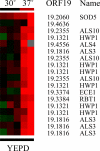Transcriptional response of Candida albicans to nitric oxide and the role of the YHB1 gene in nitrosative stress and virulence
- PMID: 16030247
- PMCID: PMC1237085
- DOI: 10.1091/mbc.e05-05-0435
Transcriptional response of Candida albicans to nitric oxide and the role of the YHB1 gene in nitrosative stress and virulence
Abstract
Here, we investigate how Candida albicans, the most prevalent human fungal pathogen, protects itself from nitric oxide (*NO), an antimicrobial compound produced by the innate immune system. We show that exposure of C. albicans to *NO elicits a reproducible and specific transcriptional response as determined by genome-wide microarray analysis. Many genes are transiently induced or repressed by *NO, whereas a set of nine genes remain at elevated levels during *NO exposure. The most highly induced gene in this latter category is YHB1, a flavohemoglobin that detoxifies *NO in C. albicans and other microbes. We show that C. albicans strains deleted for YHB1 have two phenotypes in vitro; they are hypersensitive to *NO and they are hyperfilamentous. In a mouse model of disseminated candidiasis, a YHB1 deleted C. albicans strain shows moderately attenuated virulence, but the virulence defect is not suppressed by deletion of the host NOS2 gene. These results suggest that *NO production is not a prime determinant of virulence in the mouse tail vein model of candidiasis and that the attenuated virulence of a yhb1delta/yhb1delta strain is attributable to a defect other than its reduced ability to detoxify *NO.
Figures






Similar articles
-
CTA4 transcription factor mediates induction of nitrosative stress response in Candida albicans.Eukaryot Cell. 2008 Feb;7(2):268-78. doi: 10.1128/EC.00240-07. Epub 2007 Dec 14. Eukaryot Cell. 2008. PMID: 18083829 Free PMC article.
-
A family of secreted pathogenesis-related proteins in Candida albicans.Mol Microbiol. 2013 Jan;87(1):132-51. doi: 10.1111/mmi.12087. Epub 2012 Dec 10. Mol Microbiol. 2013. PMID: 23136884
-
The Flo8 transcription factor is essential for hyphal development and virulence in Candida albicans.Mol Biol Cell. 2006 Jan;17(1):295-307. doi: 10.1091/mbc.e05-06-0502. Epub 2005 Nov 2. Mol Biol Cell. 2006. PMID: 16267276 Free PMC article.
-
Genome-wide functional analysis in Candida albicans.Virulence. 2017 Nov 17;8(8):1563-1579. doi: 10.1080/21505594.2017.1292198. Epub 2017 Mar 13. Virulence. 2017. PMID: 28277904 Free PMC article. Review.
-
Candida albicans mutant construction and characterization of selected virulence determinants.J Microbiol Methods. 2015 Aug;115:153-65. doi: 10.1016/j.mimet.2015.06.004. Epub 2015 Jun 12. J Microbiol Methods. 2015. PMID: 26073905 Review.
Cited by
-
Endogenous nitric oxide accumulation is involved in the antifungal activity of Shikonin against Candida albicans.Emerg Microbes Infect. 2016 Aug 17;5(8):e88. doi: 10.1038/emi.2016.87. Emerg Microbes Infect. 2016. PMID: 27530748 Free PMC article.
-
Environmental sensing and signal transduction pathways regulating morphopathogenic determinants of Candida albicans.Microbiol Mol Biol Rev. 2007 Jun;71(2):348-76. doi: 10.1128/MMBR.00009-06. Microbiol Mol Biol Rev. 2007. PMID: 17554048 Free PMC article. Review.
-
MaNCP1, a C2H2 Zinc Finger Protein, Governs the Conidiation Pattern Shift through Regulating the Reductive Pathway for Nitric Oxide Synthesis in the Filamentous Fungus Metarhizium acridum.Microbiol Spectr. 2022 Jun 29;10(3):e0053822. doi: 10.1128/spectrum.00538-22. Epub 2022 May 10. Microbiol Spectr. 2022. PMID: 35536030 Free PMC article.
-
Differential Behavior of Non-albicans Candida Species in the Central Nervous System of Immunocompetent and Immunosuppressed Mice.Front Microbiol. 2019 Jan 8;9:2968. doi: 10.3389/fmicb.2018.02968. eCollection 2018. Front Microbiol. 2019. PMID: 30671026 Free PMC article.
-
Novel Approaches for Fungal Transcriptomics from Host Samples.Front Microbiol. 2016 Jan 19;6:1571. doi: 10.3389/fmicb.2015.01571. eCollection 2015. Front Microbiol. 2016. PMID: 26834721 Free PMC article. Review.
References
-
- Balish, E., Warner, T. F., Nicholas, P. J., Paulling, E. E., Westwater, C., and Schofield, D. A. (2005). Susceptibility of germfree phagocyte oxidase- and nitric oxide synthase 2-deficient mice, defective in the production of reactive metabolites of both oxygen and nitrogen, to mucosal and systemic candidiasis of endogenous origin. Infect. Immun. 73, 1313-1320. - PMC - PubMed
-
- Boeke, J. D., LaCroute, F., and Fink, G. R. (1984). A positive selection for mutants lacking orotidine-5′-phosphate decarboxylase activity in yeast: 5-fluoro-orotic acid resistance. Mol. Gen. Genet. 197, 345-346. - PubMed
Publication types
MeSH terms
Substances
Grants and funding
LinkOut - more resources
Full Text Sources
Molecular Biology Databases

